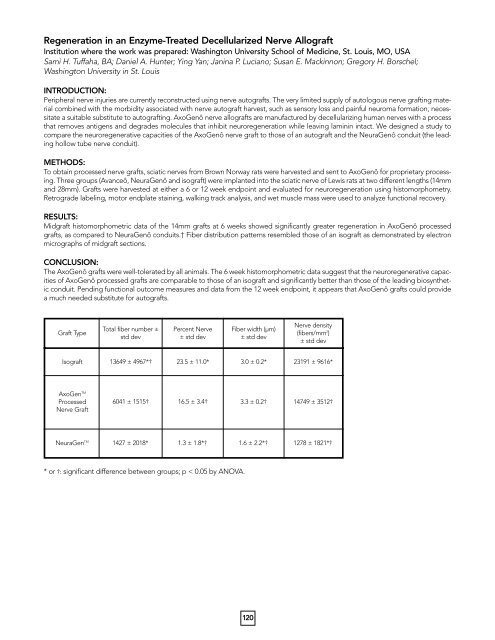Floor plan - 2013 Annual Meeting - American Association for Hand ...
Floor plan - 2013 Annual Meeting - American Association for Hand ...
Floor plan - 2013 Annual Meeting - American Association for Hand ...
Create successful ePaper yourself
Turn your PDF publications into a flip-book with our unique Google optimized e-Paper software.
Regeneration in an Enzyme-Treated Decellularized Nerve Allograft<br />
Institution where the work was prepared: Washington University School of Medicine, St. Louis, MO, USA<br />
Sami H. Tuffaha, BA; Daniel A. Hunter; Ying Yan; Janina P. Luciano; Susan E. Mackinnon; Gregory H. Borschel;<br />
Washington University in St. Louis<br />
INTRODUCTION:<br />
Peripheral nerve injuries are currently reconstructed using nerve autografts. The very limited supply of autologous nerve grafting material<br />
combined with the morbidity associated with nerve autograft harvest, such as sensory loss and painful neuroma <strong>for</strong>mation, necessitate<br />
a suitable substitute to autografting. AxoGenô nerve allografts are manufactured by decellularizing human nerves with a process<br />
that removes antigens and degrades molecules that inhibit neuroregeneration while leaving laminin intact. We designed a study to<br />
compare the neuroregenerative capacities of the AxoGenô nerve graft to those of an autograft and the NeuraGenô conduit (the leading<br />
hollow tube nerve conduit).<br />
METHODS:<br />
To obtain processed nerve grafts, sciatic nerves from Brown Norway rats were harvested and sent to AxoGenô <strong>for</strong> proprietary processing.<br />
Three groups (Avanceô, NeuraGenô and isograft) were im<strong>plan</strong>ted into the sciatic nerve of Lewis rats at two different lengths (14mm<br />
and 28mm). Grafts were harvested at either a 6 or 12 week endpoint and evaluated <strong>for</strong> neuroregeneration using histomorphometry.<br />
Retrograde labeling, motor endplate staining, walking track analysis, and wet muscle mass were used to analyze functional recovery.<br />
RESULTS:<br />
Midgraft histomorphometric data of the 14mm grafts at 6 weeks showed significantly greater regeneration in AxoGenô processed<br />
grafts, as compared to NeuraGenô conduits.† Fiber distribution patterns resembled those of an isograft as demonstrated by electron<br />
micrographs of midgraft sections.<br />
CONCLUSION:<br />
The AxoGenô grafts were well-tolerated by all animals. The 6 week histomorphometric data suggest that the neuroregenerative capacities<br />
of AxoGenô processed grafts are comparable to those of an isograft and significantly better than those of the leading biosynthetic<br />
conduit. Pending functional outcome measures and data from the 12 week endpoint, it appears that AxoGenô grafts could provide<br />
a much needed substitute <strong>for</strong> autografts.<br />
Graft Type<br />
Total fiber number ±<br />
std dev<br />
Percent Nerve<br />
± std dev<br />
* or †: significant difference between groups; p < 0.05 by ANOVA.<br />
Fiber width (µm)<br />
± std dev<br />
120<br />
Nerve density<br />
(fibers/mm 2 )<br />
± std dev<br />
Isograft 13649 ± 4967*† 23.5 ± 11.0* 3.0 ± 0.2* 23191 ± 9616*<br />
AxoGen TM<br />
Processed<br />
Nerve Graft<br />
6041 ± 1515† 16.5 ± 3.4† 3.3 ± 0.2† 14749 ± 3512†<br />
NeuraGen TM 1427 ± 2018* 1.3 ± 1.8*† 1.6 ± 2.2*† 1278 ± 1821*†



